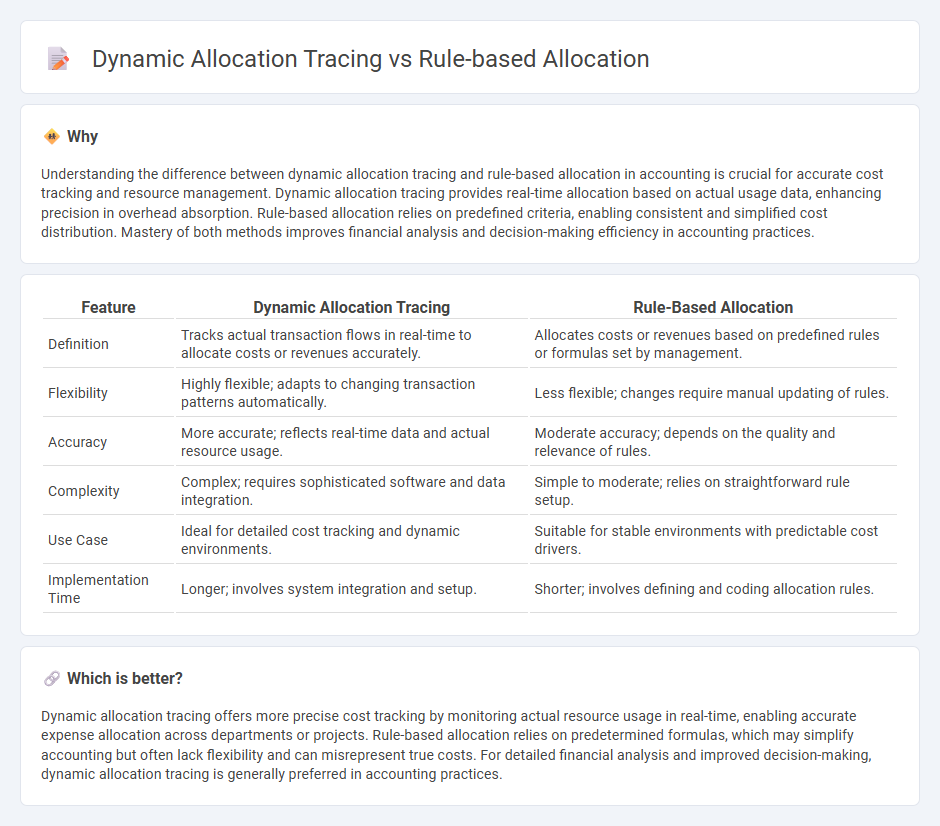
Dynamic allocation tracing in accounting enables real-time tracking of resource distribution based on actual consumption patterns, enhancing accuracy in cost management. Rule-based allocation uses predefined criteria or formulas to distribute costs systematically, ensuring consistency across accounting periods. Explore further to understand which allocation method optimizes your financial reporting and decision-making.
Why it is important
Understanding the difference between dynamic allocation tracing and rule-based allocation in accounting is crucial for accurate cost tracking and resource management. Dynamic allocation tracing provides real-time allocation based on actual usage data, enhancing precision in overhead absorption. Rule-based allocation relies on predefined criteria, enabling consistent and simplified cost distribution. Mastery of both methods improves financial analysis and decision-making efficiency in accounting practices.
Comparison Table
| Feature | Dynamic Allocation Tracing | Rule-Based Allocation |
|---|---|---|
| Definition | Tracks actual transaction flows in real-time to allocate costs or revenues accurately. | Allocates costs or revenues based on predefined rules or formulas set by management. |
| Flexibility | Highly flexible; adapts to changing transaction patterns automatically. | Less flexible; changes require manual updating of rules. |
| Accuracy | More accurate; reflects real-time data and actual resource usage. | Moderate accuracy; depends on the quality and relevance of rules. |
| Complexity | Complex; requires sophisticated software and data integration. | Simple to moderate; relies on straightforward rule setup. |
| Use Case | Ideal for detailed cost tracking and dynamic environments. | Suitable for stable environments with predictable cost drivers. |
| Implementation Time | Longer; involves system integration and setup. | Shorter; involves defining and coding allocation rules. |
Which is better?
Dynamic allocation tracing offers more precise cost tracking by monitoring actual resource usage in real-time, enabling accurate expense allocation across departments or projects. Rule-based allocation relies on predetermined formulas, which may simplify accounting but often lack flexibility and can misrepresent true costs. For detailed financial analysis and improved decision-making, dynamic allocation tracing is generally preferred in accounting practices.
Connection
Dynamic allocation tracing and rule-based allocation are interconnected in accounting as they both enhance resource management accuracy and efficiency. Dynamic allocation tracing tracks the real-time usage of resources and expenses, providing detailed insights for more precise cost distribution. Rule-based allocation leverages these insights to apply predefined criteria for systematically assigning costs, ensuring alignment with organizational policies and financial reporting standards.
Key Terms
Cost Drivers
Rule-based allocation uses predetermined criteria to distribute costs, ensuring predictable and stable cost assignments tied closely to specific activities or departments. Dynamic allocation tracing continuously monitors and reallocates costs based on real-time data, capturing fluctuating cost drivers such as labor hours, machine usage, or material consumption to enhance accuracy. Explore further to understand how these methods impact cost management and efficiency improvements in modern enterprises.
Resource Utilization
Rule-based allocation relies on predefined criteria to distribute resources, ensuring predictable and consistent utilization patterns but may lead to inefficiencies under fluctuating workloads. Dynamic allocation tracing continuously monitors real-time resource demands, enabling adaptive reallocation that optimizes utilization and minimizes waste in complex environments. Explore deeper insights into how these allocation strategies impact system performance and scalability.
Allocation Methodology
Rule-based allocation methodology relies on predefined criteria and fixed rules to assign resources or costs, ensuring predictability and consistency in traceability. Dynamic allocation tracing adapts in real-time based on data inputs and system states, offering enhanced flexibility and accuracy for tracking resource usage. Explore the nuances of each allocation methodology to optimize your resource management strategies.
Source and External Links
Allocation Rules - LemonEdge Documentation - Allocation Rules allow users to create multiple allocation methods for distributing transactions to entities or ultimate owners within a system structure.
Allocation Rules - Game Theory - Allocation rules are systematic methods used to distribute resources based on participants' preferences, needs, or contributions.
Create an Allocation Rule and Generate Allocations - This guide explains how to create and apply allocation rules in financial systems to distribute resources like costs across different units based on predefined criteria.
 dowidth.com
dowidth.com